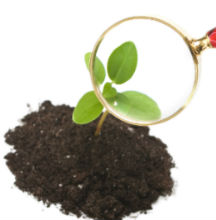
A gravel bed is an irrigated bed or pile of gravel where bare root or washed containerized stock is placed and safely held for up to 3-6 months to maximize fibrous root growth. VCE Loudoun, VCE Loudoun Master Gardeners, and Loudoun Co. Parks & Recreation combined forces and completed two gravel beds – one at Claude Moore Park and the other at Franklin Park. In partnership with Loudoun County Parks & Recreation, the parks donated the land for the constructed beds where bare root trees and shrubs are placed in the gravel to test the fibrous root growth over time. Measurements of fibrous root growth will be compared with their initial root structure when extracted for planting in the ground. The bed will be filled with saplings from mid-April through mid-October with native trees and shrubs.
Check out our project start to finish: Gravel Bed Project
Benefits of a Gravel Bed*
- “Heeling-in” plant roots is a long term alternative to holding bare rooted trees and shrubs in buckets of water for a length of time. This process is done in loose material, chosen here is pea gravel. When it is time for the trees to be planted in the soil (in autumn), these trees can be easily removed from the medium and immediately planted in a hole of proper proportions to grow!

- Why pea gravel?
- Gravel and sand don’t break down…they last forever.
- It is difficult for disease pathogens to live in sand and rocks as there is little organic matter on which they can grow.
- When plants are lifted from sand and gravel, the sand and gravel just roll off them.
- Coarse sand and gravel give the roots what they need: moisture, oxygen, support in medium (pea gravel) which gives unrestricted space for root growth.
- Plants installed in a gravel bed do not put on any noticeable growth above ground for several reasons:
- They are only in the bed for a short time – three to six months max.
- Rocks and sand have no nutritional value for leafy growth so plant puts energy into root growth.
- Bare-root plants have some distinct advantages.
- They are the lightest in weight (rarely more than 20 pounds), and cost the least (typically 20% or less of B&B trees, 30% or less of containerized trees of similar sizes).
- They are available in a wide variety of sizes (24-36 inches tall and larger), their species selection is often the most diverse, and their root systems are fully visible (no soil covering their roots). BUT large tree sizes (greater than 10’ tall or 1-3/4” caliper for shade trees, or 4’ tall for evergreens) are often limited or not available as bare-root plants, bare roots dry out easily, and nursery availability is limited to “leaf off” season (early spring, sometimes autumn).
- Fall is a better time for planting. Weather-wise, there is compelling evidence for planting in late summer through early autumn because weather extremes are less unpredictable and limiting. For instance, late summer and early autumn soil temperatures fall in the optimum range (70°-80°F) necessary for the stimulation of new root growth and recovery after transplanting. This allows newly planted trees the opportunity to take up moisture well into the traditional late autumn/early winter months and before the ground freezes.
- Weather conditions, coupled with the normal reduction in demand for water by trees and shrubs in autumn months (especially compared to unpredictable summers), have been some of the main reasons that arboreta, garden centers, nurseries, and gardening magazines have promoted the “Fall is for Planting” campaign for decades. The bottom line: greater survival rates, less labor required for continual watering, and less water usage.
- Bare root plants are usually only available in the spring – not the optimal time to plant – and the roots can dry out easily! Holding trees in the moisture rich gravel bed until fall increases the survival of trees once they are planted in the soil.
- GRAVEL BEDS ARE HOLDING AREAS NOT PRODUCTION SITES!
* From: University of Minnesota, Department of Forest Resources
Watering Requirements
The bare root saplings will be watered for 100 minutes a day using a timer and soaker hose. Four 25-minute intervals spaced out accordingly.
How to Plant Bare Root Trees
Resources
Handbook: All You Need to Know About Community Gravel Beds
University of Minnesota: Gravel Beds
Agroforestry Publications (USDA)



